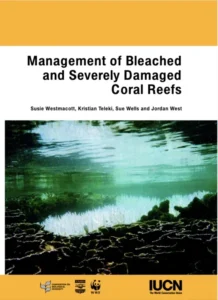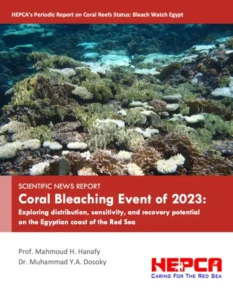Coral bleaching has become one of the most visible and damaging marine ecological impacts of persistently rising ocean temperatures. Severe coral bleaching has become more extensive, frequent, and intense. This can be seen in the acceleration of heat stress events that cause mass bleaching, and in new multi-decadal bleaching observation datasets. Mass bleaching events around the globe are often lasting many months; are becoming an annual event; and are impacting coral reefs that have never bleached before. It’s clear that monitoring coral reefs before, during and post-bleaching events, rapid on-the-ground response, communication, and enhancing coral reef resilience is critical in a rapidly warming world. [1]
Below we have compiled a collection of Resources, Material and Guides on coral reef bleaching. Should you know of any additional guidelines that are relevant please send them to Thomas Dallison at the ICRI Secretariat.

Coral Bleaching: Toolkit & Comprehensive Guide
The Toolkit and Guide is a much needed and timely online resource that consolidates information around how we understand, prepare for, and monitor coral bleaching events. This unique resource combines educational content, monitoring tools, and practical guidelines, setting managers and dive operators, as well as the general public, up for success.

Coral Restoration Consortium: Bleaching Guidance – Prepare, Act, Monitor
The guidance provides recommendations from the Coral Restoration Consortium (CRC) on how to prepare for, minimise damage to, rescue, and monitor corals during a bleaching event.

[FR] Guide à l’attention des gestionnaires des Outre-mer français pour le suivi environnemental des épisodes de blanchissement corallien et l’évaluation de leurs impacts sur le peuplement corallien (2019)
[EN] Guide for managers in the French Overseas Territories for the environmental monitoring of coral bleaching episodes and the assessment of their impact on coral populations (2019)
Dans le cadre de la programmation 2016-2020 du réseau « Récifs » de l’IFRECOR, plusieurs collectivités ont insisté sur l’importance de définir des protocoles de suivi opérationnels et standardisés ainsi que d’accompagner les gestionnaires sur la conduite à tenir en cas de blanchissement corallien. Ce besoin est renforcé au niveau international par les préconisations de l’ICRI pour mettre en place des suivis du blanchissement pragmatique et inter opérable. L’épisode de blanchissement le plus long jamais enregistré (2014-2017) ne fait que rappeler l’urgence à disposer d’un guide permettant une bonne mise en oeuvre d’un suivi des épisodes de blanchissement. Ce guide est destiné aux gestionnaires pour la mise en place des suivis du blanchissement

Coral Bleaching Risk and Impact Assessment Plan (2013)
The plan outlines the strategic approach of the Great Barrier Reef Marine park Authority (GBRMPA) for monitoring bleaching risk and assessing coral bleaching impacts when events occur. Within this document, the objectives of each of the three primary components of the plan are outlined and described in detail: Early Warning System; Incident Response; and Communications Strategy.

Resilience Assessment of Coral Reefs: Rapid Assessment Protocol for Coral Reefs Focusing on Coral Bleaching and Thermal Stress (2009)
The need for rapid methodologies for measuring coral reef resilience and their application in assessing the effectiveness of coral reef conservation management measures is becoming increasingly acute, especially in the developing world. It is therefore crucial to develop monitoring and assessment protocols to build an understanding of bleaching resistance and resilience indicators for application in management, and to determine how MPA management actions can influence resilience and resistance. This protocol is one attempt at defining some basic resilience indicators that can be quantified using rapid assessment methods.

A Reef Manager’s Guide to Coral bleaching (2006)
This guide concludes that reef managers have a critical role to play in maximising the resilience of reefs to coral bleaching. The Reef Manager’s Guide provides information on the causes and consequences of coral bleaching, and management strategies to help local and regional reef managers reduce this threat to coral reef ecosystems. Produced by the National Oceanic and Atmospheric Administration (NOAA), the Australian Great Barrier Reef Marine Park Authority (GBRMPA), and the International Union for the Conservation of Nature (IUCN), the Reef Manager’s Guide includes contributions from over 50 experts in coral bleaching and coral reef management from 30 organizations.

A global protocol for monitoring of coral bleaching (2004)
Coral bleaching and subsequent mortality represent a major threat to the future health and productivity of coral reefs. However a lack of reliable data on occurrence, severity and other characteristics of bleaching events hampers research on the causes and consequences of this important phenomenon. This article describes a global protocol for monitoring coral bleaching events, which addresses this problem and can be used by people with different levels of expertise and resources.

Management of bleached and severely damaged coral reefs (2000)
This document provides guidance for local stakeholder, managers and policy makers on appropriate management approaches for coral reefs that have been severely degraded through bleaching or other causes. The widespread bleaching event in the western Indian Ocean in 1998-9 provides a general case study that will result in recommendations of value to reef managers in all regions.
IUCN Publication

Scientific Review for the Coral Reef Bleaching Event (2023) along the Egyptian Coast of The Red Sea
This report explores coral bleaching, the mechanisms, variations in bleaching susceptibility, as well as bleaching recovery. The report also details the properties of the Red Sea and lessons learned from past bleaching events.
Ministry Environment Egyptian Environmental Affairs Agency Nature Conservation Sector
Red Sea Protectorates

Coral Bleaching Event of 2023
Exploring distribution, sensitivity, and recovery potential on the Egyptian coast of the Red Sea. The Hurghada Environmental Protection and Conservation Association (HEPCA) is committed to the preservation of Egypt’s coral reefs, particularly the Great Fringing Reef, due to the following pivotal reasons: Symbol of Hope, Unique Endemism and Socioeconomic Significance.
Scientific News Report

Global Coral Bleaching Toolkit 2024
The Reef-World Foundation has developed the Green Fins Global Coral Bleaching Response Toolkit. This comprehensive resource aims to provide guidance on how the diving and snorkelling industry — the frontline guardians of our reefs, can play a pivotal role in managing and monitoring the impacts of coral bleaching.
